Choosing the right lighting system for a soccer field involves careful consideration. Whether you are installing new lights or replacing existing ones, there are numerous factors to take into account. This comprehensive guide is designed to be a valuable resource for both experts and beginners, offering insights without unnecessary complexity.
In this ultimate guide, you’ll find answers to all your key questions. We cover everything from technical data to straightforward explanations, ensuring clarity throughout.
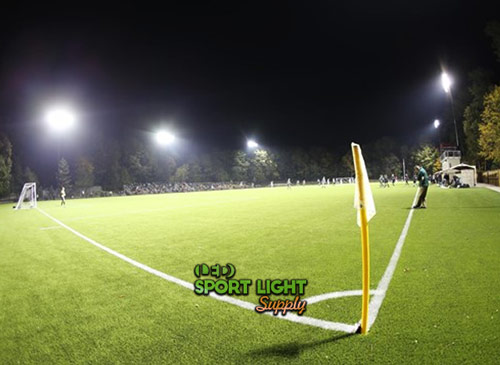
The guide will primarily focus on the optimal lighting layout for soccer fields, suitable for both stadiums and practice pitches. This information is applicable to any standard high school athletic field and is relevant whether you are managing a professional or amateur football club. With this guide, you’ll discover cost-effective solutions and valuable insights for making informed purchasing decisions or crafting a detailed contract.
We start with the basics, explaining what constitutes soccer field lighting and layout. Next, we delve into standard practices and regulations. The section on retrofitting will provide guidance on upgrading your existing fixtures. A buyer’s guide will assist you in selecting the best LED products for your soccer needs. Finally, we address pricing and frequently asked questions to cover any additional details you may need.
Table of Contents
ToggleTypes of Lights Used in Soccer Fields and Football Stadiums
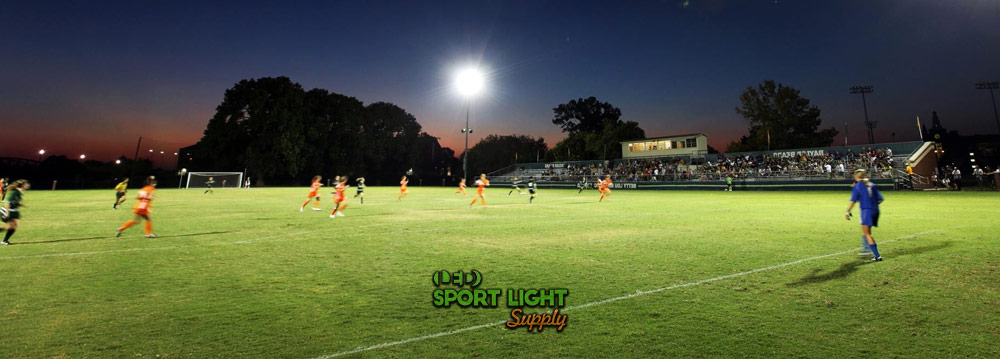
Different sports venues employ various lighting solutions based on their specific needs. For instance, a field house hosting multiple sports events may require versatile lighting setups for each activity. Conversely, a domed stadium typically features multiple lighting circuits integrated into its original design.
On a soccer field, you’ll encounter a range of lighting options, from portable lights used for temporary setups to standard fixtures commonly found in stadiums. These include high light poles and spotlights. As soccer’s popularity has grown, so has the demand for effective lighting, addressing issues such as power consumption and technical requirements.
High Mast Lighting
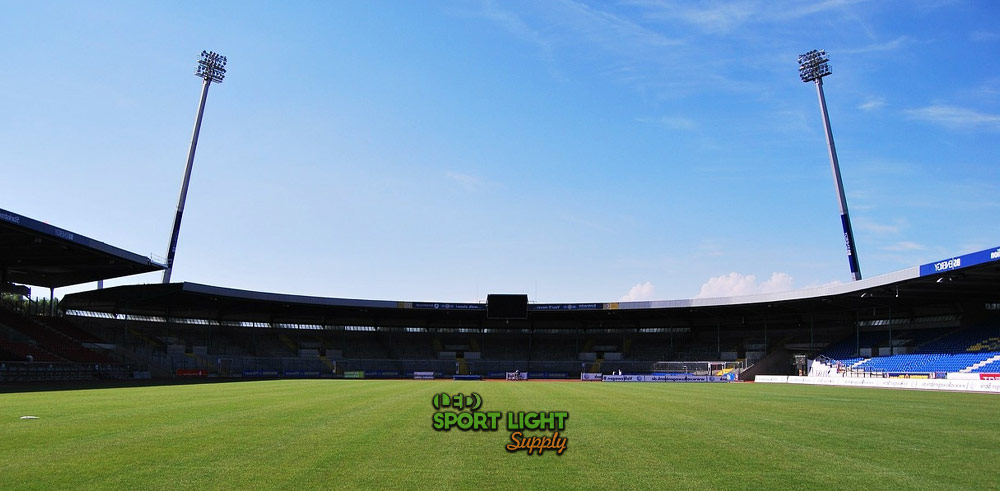
High mast lighting is a hallmark of many renowned stadiums. This type of lighting features floodlights mounted on tall poles, ranging from 20 to 50 meters in height. The layout of high mast floodlights in a stadium is meticulously planned to ensure optimal coverage and illumination.
Portable lighting solutions with similar aesthetics are known as light towers. These units typically consist of a monopole structure made of galvanized steel or other metals, supporting various components such as lamp shells, heat dissipators, and an electronic control panel. These units are designed to be waterproof and wind-resistant, with many being dustproof and featuring gasket seals to enhance durability and performance.
High Power Flood Lights
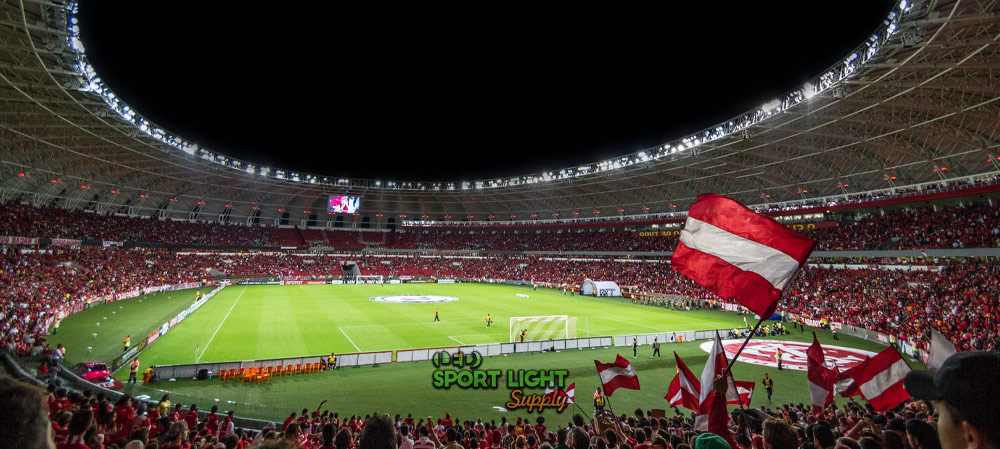
High power flood lights are essential for illuminating large areas, such as soccer fields of varying sizes. These lights offer a broad beam angle, typically greater than 45 degrees, to ensure comprehensive coverage. High power flood lights can range from 1000 to 3000 watts per LED lamp.
Modern floodlight technology primarily utilizes LED lamps, which generate light through semiconductor materials. LED flood lights are known for their long lifespan and energy efficiency, resulting in lower electricity costs. Recent advancements have introduced solar-powered LED stadium lights, which use solar panels to recharge batteries while functioning like traditional flood lights.
One of the main advantages of high power flood lights is their adjustable positioning, allowing for customization of the light angle and coverage.
Spot Lights
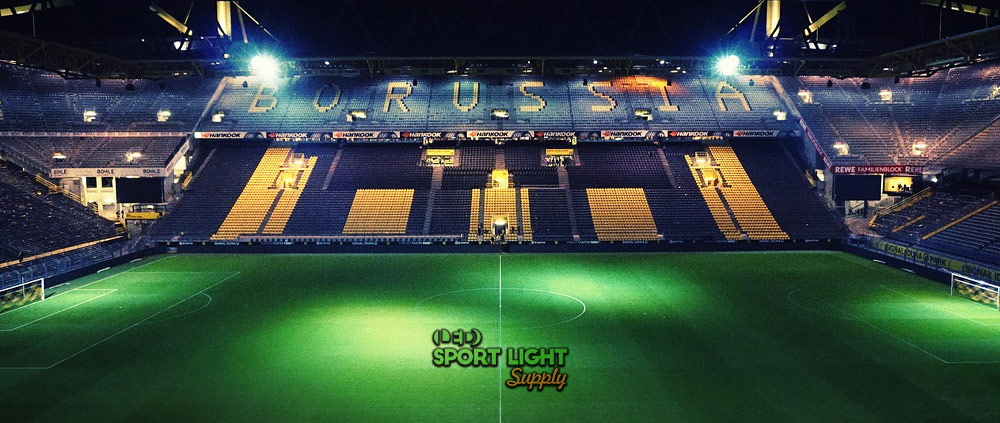
Spot lights play a crucial role in focusing light on specific areas, such as during a penalty kick. These lights have a narrow beam angle, typically less than 15 degrees, which creates a concentrated luminous path.
LED spot lights offer several benefits, including instant illumination and low heat emission. They are versatile for both indoor and outdoor use, with easy installation and transport. In a typical lighting layout, at least two spot lights are used to cover the subject from different angles, though major events like World Cup matches may require more.
RGB Flood Lights
Prestigious venues often feature RGB flood lights to enhance the visual appeal of the stadium. These multicolor LED flood lights allow for a range of colors and lighting effects, controllable via remote control or a control room.
RGB LEDs combine red, green, and blue diodes to produce various colors, with RGBW models also including white diodes. These lights are used to create vibrant, dynamic displays during breaks or events, adding a decorative element and enriching the spectator experience. They contribute significantly to the stadium’s atmosphere, offering a memorable and engaging environment for visitors.
Soccer Field Lighting Layout
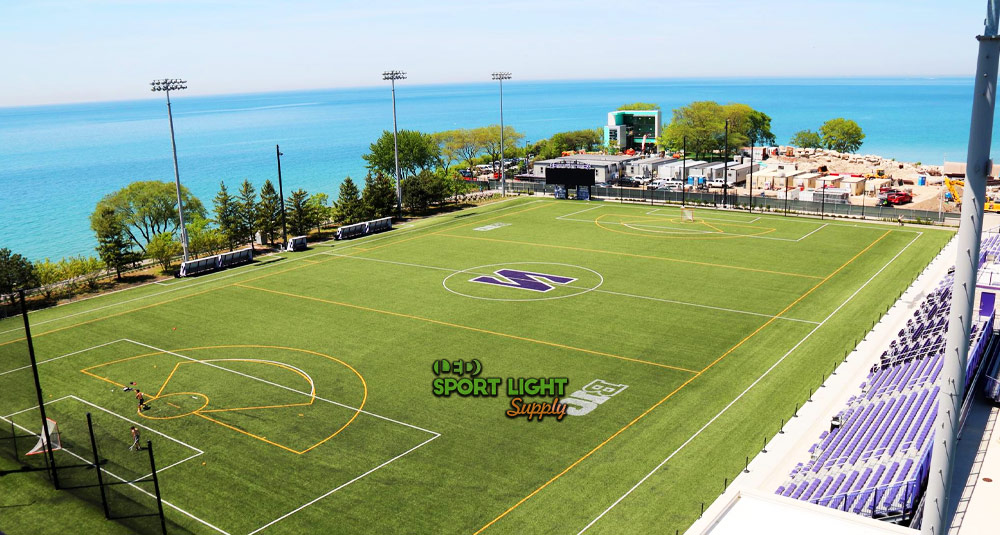
Before selecting new lighting, it is essential to design a proper lighting layout for the soccer field. The term “layout” refers to the arrangement of light poles and lighting fixtures. You can mount stadium lights on high mast poles or on the corners of a covered ceiling, depending on the specific needs of the venue.
To achieve optimal light distribution, several factors must be considered, including the pitch size and terrain quality. Engaging experts to design your stadium lighting layout can lead to benefits such as:
- High luminous efficacy
- Energy savings
- Optimal light distribution with minimal light pollution
- Compliance with regulations and requirements
Here are the key components of an effective football lighting layout:
Number of Soccer Field Light Poles
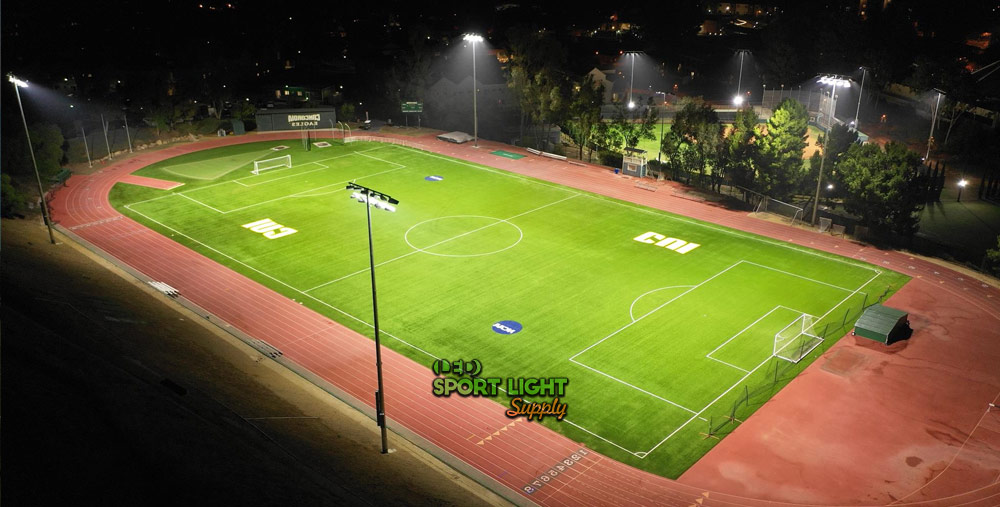
The number of light poles required depends on the need to provide adequate lighting for players, spectators, and broadcasters. Typically, LED floodlight arrangements include at least four poles, with common setups being 4, 6, or 8 poles, based on the stadium’s circuits or level of competition.
For sports facilities with fewer than 2000 spectators, a minimum of 30 horizontal footcandles should be provided on the pitch. The number of light poles impacts the lighting efficiency and design. The type of projector towers and the stadium’s specific lighting design dictate the final number of poles. It’s important to plan carefully, as relocating the foundation plinths can be challenging once installed.
Light Pole Height in a Soccer Stadium
The height of the light poles varies depending on the level of competition:
- For recreational competitions, the minimum height is 15 meters.
- For official competitive activities, the minimum height is 18 meters.
High school athletic fields often have lower poles, ranging from 8 to 20 meters. Stadiums hosting regional competitions generally have poles between 15 to 30 meters. Professional stadiums, particularly those hosting FIFA matches, require lighting systems with heights ranging from 30 to 60 meters.
The height of the light poles is crucial for minimizing glare. The angle between the line from the center of the pitch to the center of the lamp holders should not be less than 25°.
Lighting Pole Position
The positioning of light poles affects the lighting quality for different levels of soccer activities. Common positions include the corners or perimeter of the pitch, with roof-mounted options available for certain stadiums.
UEFA’s lighting guide for floodlighting suggests a layout with ten key light points:
- Multiple luminaries (or light towers) at the corners near the goal lines.
- At the corners, without focusing on the penalty areas.
- Near the penalty areas.
- Behind the penalty areas, at least 30 meters away, with a beam angle greater than 60 degrees.
- Further behind the penalty areas, at least 30 meters away, with a beam angle greater than 45 degrees.
- Along the pitch perimeter, with sufficient lateral distance to allow player movement.
- Above the pitch center line (roof-mounted).
- Further away from the pitch center line (high masts or roof-mounted), with an angle between 25 and 45 degrees.
- Perpendicular luminaires to the pitchside with angles up to 70 degrees to prevent glare.
- Additional luminaires at the pitchside to provide supplementary light and avoid shadows.
Distance Between the Light Pole and Soccer Field Sidelines
To ensure safety and unrestricted movement, a clear strip of at least 2.5 meters must surround the pitch perimeter. This space allows players to decelerate safely and provides room for medical staff if needed.
Soccer Stadium Ceiling Height
The ceiling height in indoor high school facilities is typically around 8 meters, while covered stadiums have much higher ceilings, ranging from 50 to 60 meters. For instance, the AT&T Stadium in Arlington, the highest domed stadium, has a ceiling height of 91 meters.
In general, soccer stadiums have a minimum ceiling height of 6.1 meters, which increases with the venue’s capacity. As the number of spectators grows, the need for more seats often leads to stadium reconstructions and modifications, including adjustments to the lighting layout for better distribution.
Soccer Field Lighting Design, Standards, and Regulations
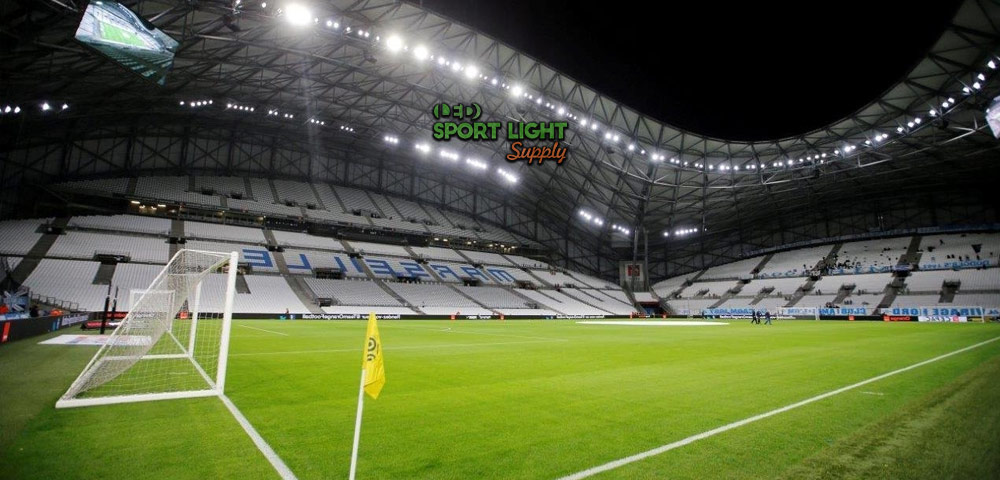
Proper lighting is crucial for soccer fields to ensure visibility and safety during both daytime and nighttime activities. The lighting design must adhere to various standards and regulations to provide adequate illumination for players, spectators, and broadcasters. Here’s a comprehensive overview of the key aspects of soccer field lighting design, including standards and regulations.
IES Soccer Field Lighting Lux & Footcandle Levels
Brightness on a soccer field is measured using specific units. The table below compares lux and foot-candle measurements:
| Measurement | Definition | Conversion |
|---|---|---|
| Lux | Amount of light received per square meter | 1 lux = 1 lumen/m² |
| Foot-candle | Amount of light received over a square foot | 1 foot-candle = 10.76 lux |
Lighting designers use these units to ensure the field meets the required brightness levels. An IES file (Illuminating Engineering Society file) provides photometric data essential for planning and verifying lighting designs. Light simulation software like 3dsMax or Agi32 helps achieve the desired lux or foot-candle values according to regulatory standards.
Lighting Uniformity Standards
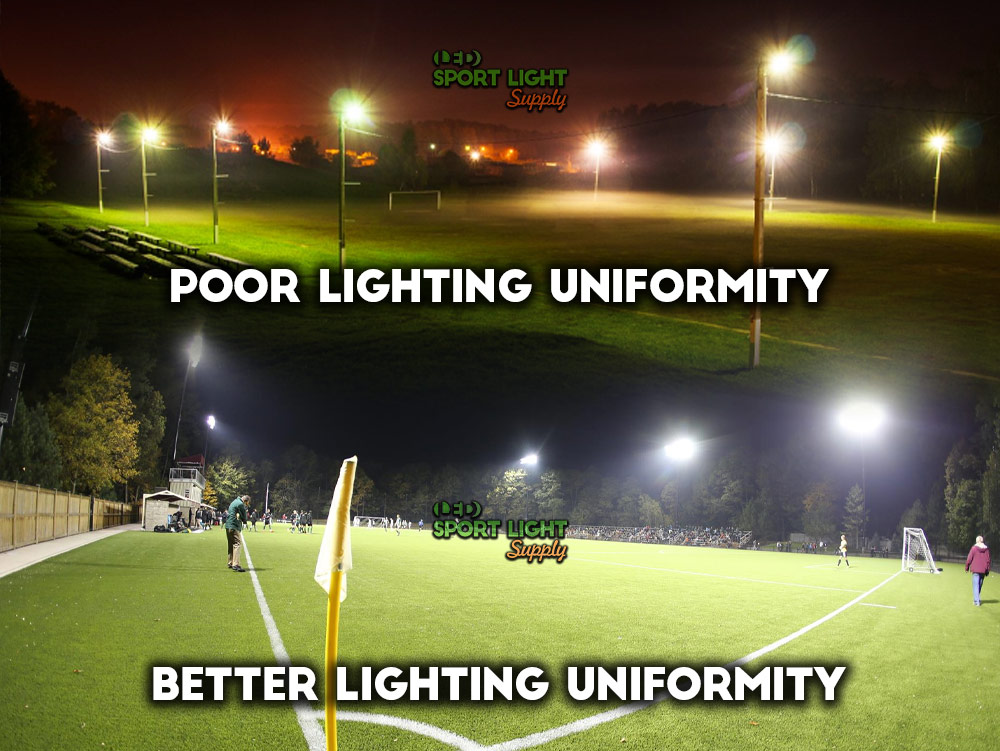
Uniformity refers to the evenness of light distribution across the field. The table below outlines the standards for uniformity and smoothness:
| Metric | Description | Standard Values |
|---|---|---|
| Uniformity | Ratio of minimum to average illuminance | 0.65 for standard fields, 0.7 for larger or international fields, <0.5 for recreational use |
| Smoothness | Evenness of light distribution between adjacent areas | 10% fluctuation in adjacent uniformity ratio is acceptable |
Achieving proper uniformity ensures that all areas of the field receive consistent lighting, reducing shadows and enhancing visibility.
Color Temperature
Color temperature affects the color of light emitted by the bulbs. The table below details color temperatures used in soccer field lighting:
| Color Temperature | Description | Typical Uses |
|---|---|---|
| Warm White | Lower temperatures (e.g., 1700K) | Used in areas like stands |
| Daylight | Higher temperatures (e.g., 6500K) | Used for the playing area |
For soccer fields, a white light is typically used for the playing area, while warmer temperatures may be used in areas like stands. The color temperature should be chosen based on the specific needs of the field and its activities.
Flicker-Free Lighting
Flicker-free lighting is essential for both player comfort and broadcasting quality. The table below outlines the issues caused by flicker and solutions:
| Issue | Description | Solutions |
|---|---|---|
| Irritation | Discomfort to players and spectators | Use flicker-free lighting |
| Distraction | Impacting performance and enjoyment | Use appropriate lighting technology |
| Physiological Issues | Such as headaches | Use high-frequency flicker-free lights |
Flicker is caused by alternating current affecting LED lights. High-frequency flicker-free lights or appropriate generators can mitigate this issue, ensuring smooth and clear video recordings.
CRI and TLCI
- CRI (Color Rendering Index): Measures how accurately a light source renders colors. A CRI value above 90 is preferred for high-quality sports lighting.
- TLCI (Television Lighting Consistency Index): Evaluates lighting for video recording. TLCI is used for broadcasting, replacing CRI for this purpose.
| Metric | Description | Recommended Value |
|---|---|---|
| CRI | Measures color accuracy | Ra > 90 |
| TLCI | Evaluates lighting for cameras | High TLCI values |
High CRI and TLCI values ensure that colors appear true to life, which is crucial for both live audiences and broadcast viewers.
Anti-Glare and Glare Rating System
Anti-glare measures are vital to prevent excessive brightness that can hinder visibility. The table below details aspects of glare control:
| Metric | Description | Purpose |
|---|---|---|
| Glare Control | Ensures light fixtures are positioned to minimize direct glare | Prevents discomfort and maintains visibility |
| Glare Rating | Evaluates the lighting system to minimize glare | Compliance with standards for minimal glare |
Changing the Illuminance Level on the Pitch
Lighting designs may need to accommodate varying illuminance levels depending on the time of day and specific requirements. Adjustments ensure that the field remains adequately lit under different conditions.
Shadowless Illumination Regulations
To avoid shadows that could impact play and visibility, lighting systems should be designed to provide even illumination across the entire field. The table below outlines measures for shadowless illumination:
| Measure | Description | Purpose |
|---|---|---|
| Even Illumination | Design to provide uniform light distribution | Avoids shadows and ensures consistent lighting |
| Strategic Placement | Placement of light poles to eliminate shadows | Enhances visibility and play quality |
Maintenance and Repairs
Regular maintenance and timely repairs are essential to keep the lighting system functioning optimally. This includes checking for issues such as bulb degradation, fixture malfunctions, and ensuring that the lighting design remains compliant with standards.
Glare
Glare is an important factor in lighting design as it can cause visual discomfort and impact safety. The glare rating (GR) system helps in evaluating and managing glare levels.
| Metric | Description | Recommended Value |
|---|---|---|
| Glare Rating (GR) | Measurement of visual discomfort due to excessive brightness | Below 50 for elite stadiums and all competition levels |
The CIE publication 112:1994 provides the basic criteria for glare evaluation, but specialized software can offer more precise calculations. The goal is to minimize glare for both players and spectators to ensure clear visibility and safety.
Pitch Illuminance Switch Mode (PISM)
The pitch illuminance switch mode (PISM) allows stadiums to use pre-set profiles to adjust lighting based on different scenarios. The table below summarizes various modes:
| Mode | Scenario | Purpose |
|---|---|---|
| Match Start | Lighting for regular matches | Ensure optimal visibility for gameplay |
| Power Failure | Backup lighting mode | Maintain illumination during power interruptions |
| Training Session | Lighting for practice sessions | Provide adequate light for training activities |
| Repairs | Lighting during maintenance | Ensure safety and functionality during repairs |
These modes are created based on initial measurements of horizontal and vertical illuminance and adjusted according to the event type, such as televised or non-televised matches. The use of PISM helps in managing energy costs and configuring lighting efficiently.
Shadowless Illumination Regulations
To achieve shadowless illumination, lights should be positioned to eliminate shadows on the soccer field. The following table outlines the regulations and considerations:
| Metric | Description | Requirements |
|---|---|---|
| Shadowless Illumination | Lighting layout to minimize shadows | Lights should come from multiple directions to avoid shadows |
| UEFA Regulation | Allows for soft shadows if complete shadowless illumination is not possible | Soft shadows are acceptable under UEFA standards |
| Lighting Positions | Impact of light pole positions on shadow creation | Use multiple light sources to avoid dark areas |
Effective positioning of light poles and using multiple light sources help in reducing shadows, enhancing visibility, and ensuring uniform lighting.
Maintenance Factor
Maintenance is crucial to ensure the longevity and effectiveness of the lighting system. The table below provides guidelines on maintenance factors:
| Metric | Description | Recommended Value |
|---|---|---|
| Maintenance Factor | Adjusts for light degradation over time | Ranges from 0.85 to 0.70, depending on competition level |
| Design Considerations | Ease of maintenance, cleaning, and lamp replacement | Simple design with accessible parts for maintenance |
| Periodic Maintenance | Regular checks and records of changes and repairs | Essential for long-term performance and cost management |
The maintenance factor reflects the need to account for light degradation, dirt accumulation, and other factors affecting performance. Regular maintenance and proper design choices help in minimizing costs and ensuring consistent lighting quality.
Soccer Field Lighting Replacement and Retrofit Guide
Benefits of Replacing Metal Halide, Halogen, and HPS Lights with LEDs
Switching from older lighting technologies such as metal halide, halogen, and high-pressure sodium (HPS) to LED lights offers significant advantages. LED lights are known for their cost-effectiveness, extended lifespan, and improved energy efficiency. Traditional lighting technologies often consume large amounts of electricity and require frequent repairs. Metal halide, halogen, and HPS lamps not only have high operational costs but also pose disposal issues; for instance, metal halide lamps contain toxic mercury vapor.
LED flood lights, in contrast, provide a higher luminous flux with lower power consumption. They are approximately five times more efficient than incandescent and halogen lamps. The efficiency of LED technology is attributed to the fact that only a minimal amount of absorbed energy is converted into heat, keeping the lamps cool even after extended use. In contrast, older lighting technologies such as HPS, halogen, and metal halide lamps generate excessive heat, which can lead to overheating and damage to both the lamp and its casing.
Replacing Metal Halide Soccer Field Lights
To replace metal halide lights with LEDs, the process typically begins by selecting an LED light with equivalent power output. For instance, a 300W LED light can replace a 1000W metal halide lamp, achieving a significant energy savings of around 70%. An electrical engineer is usually required to first assess the current lighting system. This assessment involves studying the existing metal halide lights to determine the necessary retrofit interventions.
The retrofit process generally includes modifying reflectors to center on new focal points suitable for LED lights, assembling the lighting circuit by integrating the LED module, heat sink, fixing bracket, and power supply with the existing light poles or ceiling mounts, and installing the LED lamps. After installation, testing is conducted to ensure optimal performance, including adjusting color contrasts as needed.
Replacing Halogen Soccer Stadium Lighting
When replacing halogen lights with LEDs, a power-equivalent LED light can lead to energy savings of up to 50%. It is essential to focus on lumen output rather than wattage when choosing a replacement. Traditional halogen lamps are characterized by a consistent wattage ratio, but LED technology offers separate values for wattage and lumen output. LED lights provide better luminous efficiency and lower consumption compared to halogen lamps.
To find the appropriate LED replacement, one can either consult with a sports lighting contractor or review the technical specifications and datasheets of potential LED lights. Comparing the lumen output of different LED options will help determine the most suitable replacement for the old halogen flood lights.
Retrofitting HPS Soccer Pitch Lighting
Retrofitting HPS lights with LEDs can result in energy savings ranging from 50% to 80%, as fewer LED lamps are required to achieve the same illuminance output. HPS lights are known for emitting yellow light, which does not align with the spectral sensitivity of the human eye, resulting in poor color reproduction and a low color rendering index (CRI) of around 20. Consequently, more light is needed to ensure adequate visibility.
LED lights, in contrast, offer both warm and white light options with improved CRI values. When retrofitting HPS lights with LEDs, it is necessary to replace the entire lighting system rather than just the lamps. This replacement involves removing the components of the HPS lighting system, which include various elements for gas ignition, and installing the LED lighting system that utilizes an electronic circuit. Hiring a specialist for this process ensures a safe and efficient installation.
Common Mistakes When Retrofitting Soccer Field and Stadium Lighting
Retrofitting soccer field and stadium lighting can be complex, and overlooking critical steps can lead to problems. Here are some common mistakes to avoid, ensuring a successful lighting upgrade:
Selecting the Right Equivalent Lamp
One of the most frequent errors in retrofitting is choosing the incorrect power equivalent lamp. For metal halide and HPS lamps, ensure that the replacement LED lights match the wattage of the existing fixtures. However, when replacing halogen lamps, it is crucial to compare lumen values rather than wattage alone. Halogen lamps and LEDs differ significantly in efficiency and light output, so relying solely on wattage could lead to inadequate illumination.
Choosing the Appropriate LED Power Supply
Another critical mistake is failing to purchase a compatible LED power supply. If the power supply is not suited to the new LED lights, they may not function correctly. Issues such as the lights not turning on or overheating can arise, leading to premature failure or deterioration. Always check the voltage and specifications of the power supply to ensure compatibility with the LED lights.
Ensuring Compatibility with the Lighting Control System
The compatibility of the new LED lights with the existing lighting control system is essential. Incompatibility can result in issues with controlling the lights or might prevent them from being controlled altogether. It is important to verify that the lighting control system can accommodate the new LED fixtures. If necessary, seek maintenance services to ensure that signal connections and controls are properly aligned with the new lighting setup.
Correctly Replacing Flood Lights and Spot Lights
When retrofitting, it is important to replace flood lights and spot lights with their respective counterparts. Mixing these types can result in incorrect beam angles and uneven lighting. Flood lights and spot lights serve different purposes, and using them interchangeably can lead to suboptimal lighting conditions. Ensure that each type of light is replaced with a corresponding type that maintains the correct beam angle and distribution.
Conducting Thorough Testing Procedures
Thorough testing is crucial and should not be overlooked. Many stadium owners neglect periodic testing, which can lead to issues such as incorrect color temperature or diminished performance due to the gradual deterioration of LED diodes. Regular testing helps ensure that the lighting system meets the desired standards and performs optimally over time. Conduct comprehensive testing to verify the lighting quality and address any potential issues promptly.
How to Select the Best Soccer Field Lights: A Buyer’s Guide
Type of Lighting
When selecting soccer field lights, the type of lighting plays a crucial role. Various options are available, each with unique characteristics. Metal halide (MH) lamps are a type of gas-discharge lamp containing a quartz discharge tube filled with high-pressure mercury or sodium vapors and metal halides. These lamps produce a white light with a bluish tint.
High-pressure sodium (HPS) lamps, developed in the early 20th century and widely used since 1970, emit a yellowish to reddish light. Halogen lamps, a type of incandescent light, offer enhanced features compared to standard household bulbs, providing a brighter and whiter light.
Light-emitting diodes (LEDs) represent a modern technology that converts electric current into visible light with high efficiency and longevity.
Energy Efficiency
Energy efficiency is evaluated by the ratio of luminous flux (lumens) to input power (watts). This ratio indicates how effectively a light source converts electricity into visible light. The luminous efficiency depends on the light source’s ability to emit light within the visible spectrum. Radiation outside this band, such as infrared or ultraviolet, does not contribute to perceived brightness.
The cost-effectiveness of various lighting technologies can be ranked as follows:
| Lighting Type | Efficiency Ranking |
|---|---|
| High-Pressure Sodium (HPS) | Least cost-effective |
| Metal Halide (MH) | Intermediate cost-effective |
| Halogen | Better cost-effective |
| LED | Most cost-effective |
Soccer Field Lighting Wattage
Due to the extensive area of a soccer field, high wattage lights are essential. Common wattages for LED lights include 1000, 1500, and 2000 watts. In comparison, Metal Halide, HPS, and halogen lamps produce fewer lumens for the same wattage.
When choosing lighting, consider the overall wattage and ensure the lights have appropriate protection. For high-performance floodlights, look for a casing that is waterproof and dust resistant, with an IP rating of 65, which offers both protections and is commonly used for soccer stadium lights.
Life Span
The life span of a light bulb can vary significantly depending on usage and aging. Common light sources for soccer fields have the following average lifespans:
- Halogen bulbs typically last up to 2,000 hours.
- Metal Halide lamps provide illumination for about 6,000 hours.
- High-Pressure Sodium lamps usually last between 6,000 and 8,000 hours.
- LEDs have an extended life span of up to 150,000 hours.
If you experience frequent bulb failures, check for potential issues such as overheating, old lamp holders that cause thermal shocks, faulty ignition switches, or low-quality bulbs.
Color Temperature
Color temperature, measured by the Correlated Color Temperature (CCT) index in degrees Kelvin (K), indicates the hue of the light. Bulbs with lower Kelvin values produce a warmer, yellowish light, while those with higher Kelvin values emit a cooler, bluish light.
For official soccer events, the optimal color temperature ranges from 5,000 to 6,200K. For instance, UEFA requires a minimum color temperature of 4,200K. One advantage of LED lighting systems is their ability to adjust color temperature, allowing the lighting to adapt to natural variations during matches, particularly in the late afternoon.
Beam Angle
The beam angle of lighting fixtures plays a crucial role in providing comfortable visibility for both players and spectators. Flood lights and spot lights each offer different benefits based on their beam angle. Flood lights should have a beam angle between 25° and 45° when positioned relative to the field, while spot lights typically have a 30° beam angle when mounted perpendicular to the pitch. However, to avoid glare, the beam angle on the ground level should be kept below 60°.
For optimal results, do not set flood light beams perpendicular to the pitch at angles exceeding 70°. Flood lights generally offer a beam angle range from 30° to 150°, whereas LED downlights range between 30° and 60°. LED spot lights provide a wider range, from 15° to 90°, giving you ample options to suit your stadium’s needs.
Anti-Glare Feature
Anti-glare lighting utilizes filters and diffusers to soften the light and reduce glare. A micro-prismatic anti-glare diffuser helps in achieving a more uniform and less harsh light, while a reflector system can enhance both light uniformity and anti-glare effects. This feature is particularly important for reducing eye strain and preventing glare-induced visibility issues, which can pose safety risks and lead to potential injuries.
Anti-glare technology is often indicated on product labels or in technical specifications. While not all lighting fixtures come with this feature, it is essential for maintaining high visual comfort in significant soccer venues.
Lighting for Mobile Light Towers vs. Conventional Light Poles
When the lighting layout on a training pitch is inadequate, especially in smaller or less advanced facilities, mobile light towers offer a practical solution. They are particularly useful for high school fields or other venues where standard flood lights fall short. Mobile light towers come in two main variants: those with trailers for more demanding setups and those without, often lacking generators.
For primary soccer fields or official events, conventional light poles are preferable. High masts are necessary for optimal performance and are typically used in permanent installations. Mobile LED flood lights are best utilized as supplemental lighting rather than primary sources.
Lighting Control System
Lighting control systems allow for sophisticated management of light effects, including dimming and color adjustments. Ensure compatibility with DMX or DALI systems for efficient control. DMX is particularly effective for controlling RGB lights and offers fast, precise control. DALI manages various aspects of lighting control, including electronic ballasts, brightness levels, and integration with presence sensors and command modules.
Weight of Lighting Fixtures
The weight of lighting fixtures is an important consideration, as excessive weight may require reinforcing the light pole. The ability of a light pole to resist wind pressure is affected by the combined weight of the pole, fixtures, and any accessories. Consult the UNI EN 40-6:2004 standard for guidance on structural requirements. If needed, seek advice from a contractor or engineer to ensure the pole can safely support the lighting setup.
Installation Accessories
Proper installation of lighting fixtures often requires accessories such as laser pointers and professional light meters. Laser pointers help accurately aim the light beam, while light meters are essential for measuring light intensity and deterioration over time. Additionally, stainless bird spikes can protect your fixtures from potential damage caused by birds, which may be attracted to the warmth of outdoor lights.
Warranty
When purchasing lighting fixtures, consider the warranty offered as it is a crucial factor in ensuring long-term satisfaction. An attractive price should not overshadow the importance of a comprehensive warranty. Ensure you have clear information on how to contact customer support and keep all relevant documentation for future reference. Evaluating the warranty period can significantly impact your return on investment and overall satisfaction with the product.
Average Soccer Field Light Cost
When planning for soccer field lighting, it’s essential to consider both the initial cost of purchasing the lights and the installation expenses. The total investment can vary widely based on the facility type, the level of illumination required, and additional factors such as installation complexity and electrical upgrades. Here is a detailed breakdown of the costs involved:
Cost of Buying Soccer Field Lights
The cost of purchasing soccer field lights depends significantly on the level of the facility and the quality of the lighting required. Here is a more detailed look at the potential costs:
| Facility Type | Cost Range | Description |
|---|---|---|
| Training Facilities | $10,000 to $50,000 | This range typically covers basic flood and spot lights suitable for practice sessions. These lights provide adequate illumination for training but may not meet higher standards required for competitive play. |
| High School Fields | $50,000 to $150,000 | For high school facilities, the lighting must meet certain standards to ensure proper visibility for both players and spectators. This cost range includes more advanced flood and spot lights capable of supporting high school-level games. |
| Professional Stadiums | $150,000 to $500,000 | Professional stadiums require top-tier lighting solutions that meet stringent standards for broadcasting and high-quality game play. This cost range reflects the investment in high-end flood lights and spot lights designed to deliver exceptional performance. |
Although LED lights may come with a higher initial price tag compared to traditional lighting options, they offer significant advantages in terms of energy efficiency, longevity, and reduced maintenance costs. LEDs can help offset the higher upfront costs through savings on electricity and reduced frequency of replacements.
Cost of Installing Stadium Lights
The installation process for soccer field lights can sometimes exceed the cost of the lights themselves. The following table outlines typical installation costs and factors that influence the total price:
| Type of Installation | Cost Range | Additional Information |
|---|---|---|
| Premier League Stadiums | $70,000 to $250,000 | The cost of installing lighting for a professional stadium includes the installation of multiple high-quality lights, necessary fixtures, and supporting infrastructure. The price can vary based on the stadium’s size and specific requirements. |
| Electrical Servicing Upgrades | $500 to $1,900 | Upgrades such as changing an electrical panel or enhancing the existing electrical infrastructure are essential for accommodating new lighting systems. Costs depend on the complexity of the upgrades needed. |
| Retrofitting Existing Stadiums | Starting at $350,000 | Retrofitting involves upgrading an existing lighting system to meet new standards or improve performance. This cost includes both the installation of new fixtures and any required modifications to the existing infrastructure. The total cost can increase depending on the extent of the changes required. |
The installation cost can vary based on several factors, including the type of lighting fixtures chosen, the complexity of the installation, and the existing conditions of the site. Additional costs may arise from the need for specialized equipment or labor, as well as potential electrical upgrades.
Soccer Pitch Lighting Q&A
Here’s a comprehensive overview of common questions about soccer pitch lighting, including details on wattage, types of lights, and their operational characteristics.
What Wattage Are Stadium Lights?
The wattage required for stadium lights can vary significantly based on the facility’s size and specific lighting needs. Typically, the wattage ranges from 30,000 to 250,000 watts. This broad range accommodates different types of stadiums, from high school fields to professional arenas. Factors influencing the wattage include the number of fixtures installed, the type of lighting technology used, and the particular requirements of the stadium. For instance, larger venues with higher lighting standards will need more powerful systems to ensure adequate visibility and performance.
To put it into perspective, a World Cup arena, known for its extensive lighting requirements, consumes approximately 25,000 kWh per match. This amount of energy is roughly equivalent to the annual electricity consumption of nine average households. Properly designed lighting is crucial for maintaining optimal performance while also adhering to regulatory standards. Inadequate or improperly configured lighting can lead to issues such as light pollution, which not only affects the immediate area but also has broader environmental impacts. Ensuring that the wattage aligns with regulatory requirements is essential for both effective performance and environmental compliance.
What Are Stadium Lights Called?
Stadium lights are known by various names, each reflecting their specific function and design within the lighting system. Floodlights are designed to produce a broad beam of light, similar to street lighting systems. In stadiums, floodlights are mounted on tall poles and usually feature multiple fixtures to achieve the necessary lux or footcandle values for illuminating the entire field. These lights are essential for providing consistent and widespread illumination across the playing surface.
Spotlights create a narrow, focused beam of light. They are often used to highlight specific areas of the field, such as the penalty box or other critical zones. Downlights are another type of stadium lighting, providing a downward-directed beam. These are typically used at entrances or emergency exits, where they offer customizable beam angles and are often recessed into walls or ceilings. Each type of stadium light serves a specific purpose, contributing to the overall effectiveness of the lighting system in enhancing visibility and safety.
How to Turn On Soccer Field Lights
Turning on soccer field lights can vary depending on the age and technology of the lighting system installed. In older stadiums, the lights may be controlled through a manual electrical box or control panel, which might require a specific code or sequence to operate. This setup can be somewhat cumbersome, especially if the system is outdated or not user-friendly.
Modern sports facilities typically employ more advanced control systems. A centralized control system, often using the DMX (Digital Multiplex) protocol, is commonly used to manage lighting for sports and entertainment events. This system allows for sophisticated control over lighting intensity and effects, including programmable scenarios and RGB color options. The centralized system enhances the overall experience by enabling various lighting effects and adjusting brightness levels to suit different phases of the event, from regular play to spectacular light shows during breaks. This modern approach provides greater flexibility and control, improving both player and spectator experiences.
Why Do Stadium Lights Take Long to Turn On (for Metal Halide)?
Metal halide lamps are known for their slow start-up times, often requiring up to eight minutes to reach full brightness. This delay is due to the complex ignition process involved in these lamps. When first turned on, metal halide lamps have metal vapors deposited on their internal walls. As the lamp heats up, these vapors evaporate and spread throughout the lamp, eventually creating visible light. The process involves a pulse igniter, which generates a high-voltage breakdown necessary to initiate the lamp’s operation. This ignition process takes time, contributing to the extended warm-up period.
The slow warm-up is a trade-off for the high-quality light output and efficiency that metal halide lamps provide. When the lamp is cold, metal halides are deposited on the walls and must vaporize before they can provide light. Additionally, turning the lamp off and then back on again will add another ten minutes to the start-up time due to the need for the lamp to cool and reheating. Despite these delays, metal halide lamps are valued for their ability to produce high-intensity light, making them suitable for environments where high-quality illumination is essential.
How Much Does It Cost to Put Lights on a Soccer Field?
The cost of installing lights on a soccer field extends beyond just the purchase of the luminaries and the installation service. Additional expenses may include updating power lines, addressing soil stability issues, and other preparatory work. For a high school soccer field, the overall cost is typically in the range of $70,000 to $100,000. This estimate covers the basic installation and setup of lighting systems.
For larger stadiums, where specialized equipment and professional testing are required, costs can escalate significantly. In such cases, the total cost can rise to $800,000 or more. Renovations and upgrades to existing lighting systems can also fall within this budget range. The final cost will depend on factors such as the complexity of the installation, the specific requirements of the facility, and any additional work needed to ensure a successful lighting setup.
Symmetric vs. Asymmetrical Soccer Stadium Lighting
The choice between symmetric and asymmetrical lighting plays a crucial role in the effectiveness of stadium illumination. Symmetrical lights produce an even distribution of light across the field but can lead to glare and eye strain, which makes them less suitable for sports lighting applications. These lights are often less efficient in managing light distribution and can result in less effective coverage.
Asymmetrical lights offer better control over light distribution. They provide a wider beam angle and allow for more precise placement of light, which reduces glare and improves overall visibility. This type of lighting is preferred in modern stadiums due to its efficiency in directing light to where it is needed most. Asymmetrical lighting systems enable the use of more powerful and cost-effective LED lights, contributing to energy savings and a reduction in light pollution. This approach enhances the lighting quality while also supporting environmental sustainability.
Where Was the First Floodlit Soccer Match Played?
The first official floodlit soccer match took place at Fratton Park, Portsmouth, on February 22, 1956. Despite initial issues with the floodlight system, the problem was resolved in time for the match, which saw Newcastle United defeat Portsmouth 2-0. This historic event marked a significant milestone in the use of floodlighting in soccer.
Earlier experiments with floodlighting were conducted in Sheffield, UK, in 1878, but these were not adopted for official matches. The first floodlit friendly tournament occurred at Southampton FC’s stadium on October 31, 1950. Today, most stadiums utilize advanced LED lighting systems, which allow for impressive lighting designs and enhanced visual experiences, reflecting the evolution of stadium lighting technology.
Conclusion
This guide on soccer field lighting has covered essential and technical aspects for both stadiums and high school fields. To ensure optimal results, review the regulations from your football association and consider consulting experts for your lighting design.
Thorough testing is crucial to achieving the right illumination levels. By following the guidelines and making informed choices, you can enhance field visibility and comply with industry standards. For further assistance, refer to our sections on retrofitting and purchasing new lights.
